Safety Around Pools a Part of Home Security
- Share via
Swimming pools are as much a part of Southern California’s lore as palm trees and sunshine. But unfortunately, pools are also among the Southland’s biggest killers.
Nearly 1,000 Americans died in their pools or spas last year, most of them victims of accidental drownings. About three-quarters of those casualties were children.
Drowning is the leading cause of death for Southland children under age five. Thousands more swimmers suffer injuries every year.
“It’s odd, how some people will spend thousands of dollars to protect their home from burglars but don’t even think about making their pool area safer for their own family,” said Paul Loomis of Olin Corp., a company that makes pool-cleaning chemicals and equipment.
Most cities, including Los Angeles, require that pools be fenced in to prevent toddlers and other nonswimmers from accidentally wandering into the water. Locks or latches are typically also required.
You can usually get the specific requirements for your area by calling the local Building and Safety Department.
Remember, though, that even the youngest of children can walk through an unlatched gate or somehow manage to get through a fence. For an extra layer of protection, consider purchasing a cover made of reinforced vinyl that’s at least strong enough to hold one full-grown adult.
“It’s important to do all you can to make your pool ‘child-safe,’ but you have to remember that adults have accidents too,” said Tony Amoroso of Aquamatic, a big cover manufacturer headquartered in the City of Industry.
“What happens if a grown-up who can’t swim falls in, and there’s no one else around? Or what if he’s had too much to drink, or is disabled?”
The covers can be expensive: Some cost more than $5,000, fully installed. But if it saves a life, it’s obviously money well-spent.
Also remember to always have a first-aid kit and lifesaving equipment nearby. “That includes a ring life-preserver, and a ‘reaching pole’ or shepherd’s hook that you can use to reach someone who’s in trouble,” said Peggy McGinley of the American Red Cross.
“Your first-aid kit should at least include bandages, gauze and cleansers for minor accidents,” McGinley said.
Other tips to make your pool more secure:
* Never let children use a pool without adult supervision.
* Keep a telephone near the pool and post emergency numbers and safety instructions nearby. “People don’t always think straight when an accident happens,” McGinley said. “When you’re in a panic, you might not even remember the numbers 9-1-1.”
* Don’t allow running, pushing or boisterous play. Also remember that bottles, glasses and sharp objects don’t belong near the water.
* Clearly mark where the shallow part of the pool ends and the deep part begins. You can do this by running a buoyed line across the water. Don’t allow diving into unsafe depths.
* Never swim in a thunderstorm. Keep any electrical appliances as far from the water as possible to reduce the chance of electrical shock.
* If you don’t already know some basic first-aid--including mouth-to-mouth resuscitation and cardiopulmonary resuscitation--take a class. Inexpensive, one-day courses are offered by the Red Cross, many colleges and other agencies.
* Don’t assume that flotation devices, such as inflatable mattresses or toys shaped like animals, can substitute for life jackets or life preservers. Most of them can easily deflate, and many are prone to tipping over.
The chapter of the Red Cross nearest you can provide you with free brochures about safe swimming and pool security.
Olin Corp. also offers a free brochure, “Poolside Matters,” that provides important tips and guidelines about pool safety and maintenance. It also has a toll-free “hot line” staffed by experts who can answer most pool-safety and water-quality questions.
You can get the brochure or talk to an Olin water-safety expert by calling (800) 222-2348.
More to Read
Sign up for Essential California
The most important California stories and recommendations in your inbox every morning.
You may occasionally receive promotional content from the Los Angeles Times.













